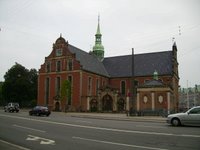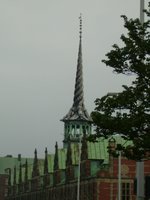Walking City Tour...
 Como ponerme yo a contaros lo que vi sería horrible, he preferido colgaros en qué consiste el tour en cuestión de lo que he sacado de una página web, eso sí, aderezado con mis fotitos. He de advertiros, empero, que no lo hicimos exactamente en este orden, pero buno, os servirá...
Como ponerme yo a contaros lo que vi sería horrible, he preferido colgaros en qué consiste el tour en cuestión de lo que he sacado de una página web, eso sí, aderezado con mis fotitos. He de advertiros, empero, que no lo hicimos exactamente en este orden, pero buno, os servirá...Así pues... welcome to Copenhage!!!!
This tour is a circular tour taking you around the inner city of
The tour around the inner city begins at the City Hall Square of today in front of the City Hall created by the Architect Martin Nyrup and built 1892-1905. This is the home of the city council. It is open to the public and you are welcome to take a look inside with or without a guide.
 Otherwise cross the street at the big crosswalk on your right, when standing with your back to the City Hall. If there is anything like a main street in
Otherwise cross the street at the big crosswalk on your right, when standing with your back to the City Hall. If there is anything like a main street in
Leave the square at the opposite corner by the street Nørregade. In the beginning of Nørregade you find The Cathedral of
Across from Sankt Petri you find the side-street Krystalgade, where you turn right. Down the street after crossing the small pedestrian street Fiolstræde, you find the Synagogue on your left. This is the main synagogue of the Jewish Community in 
Follow Krystalgade to its end at Købmagergade, where you face the
Todavía no he podido subir, pero nos contaron que por dentro no tiene ni un solo escalón. Como tenía que subir todos los aparatos de astronomía arriba, pues lo de las escaleras no era muy operativo que digamos.
(…) he quitado cosas de aquí porque aún no las he visto!!!
 As you follow the square clock-wise you pass the Royal Theatre, Det Kongelige Teater, which is also the national theatre of Denmark. It was built in 1872-74 and is home to The Royal Danish Ballet and Opera as well as staging plays. The statues in front of the main entrance show the poet Adam Oehlen-schläger and the Playwright Ludvig Holberg.
As you follow the square clock-wise you pass the Royal Theatre, Det Kongelige Teater, which is also the national theatre of Denmark. It was built in 1872-74 and is home to The Royal Danish Ballet and Opera as well as staging plays. The statues in front of the main entrance show the poet Adam Oehlen-schläger and the Playwright Ludvig Holberg.
As you pass the theatre turn left and follow the street Holmens Kanal (once a canal now a street), as it curves to the right (on the righthand-side). At the end of the curve you can't help noticing the monumental Functionalistic building, which houses The National Bank of 
Across the street from the bank you will see the Royal Chapel and Naval church Holmens Kirke. The church started out as a converted smithy in 1619, but extra wings and the long chapel along the canal were added over the years. The church was renovated in 1871-72 and because it has survived the many fires of
 As you cross the canal by Holmens Bro you access Slotsholmen (
As you cross the canal by Holmens Bro you access Slotsholmen (
Chicos, es la foto de la izquierda, y arriba del todo, cabe una persona de ie con los brazos pegados al cuerpo. Es un edificio que tiene mil ventanucos y entradas por donde entrabas las ovejas y demás mercancía, el edificio de al lado, que ahora es el parlamento antes era el Palacio Real, de tal manera que el Rey se pasaba por allí from time to time a ver qué pillaba antes de dejar a los  mercaderes que hiceran su trabajo.
mercaderes que hiceran su trabajo.
On your right is
Walk through the portal on the left-hand side of the castle. Inside the courtyard you pass the entrance to the parliament on your right and as you turn left you enter through the gates to the peaceful Library Garden, guarded by a statue of the national philosopher Søren Kierkegaard sitting down to your right. In front of you lies the old part of the Royal Library, Det Kongelige Bibliotek, built at the turn of the 19th century. In
El jardín, como veréis en la foto de abajo, es precioso. Yo me quedé impresionada. Muy pacífico, además, no se escuchaba ni in ruido. A la derecha de donde yo estoy posando, hay una estatua bastante grande de el existencialista Soren Kierkegaard. La guía, ya que estábamos aquí, aprovechó para contarnos la VERDADERA leyenda de la Sirenita y, ¿sabéis qué? los de Disney son unos mentirosos... ni casamiento, ni bonita historia de amor ni nada!!! el Príncipe pasa de la sirenita, se casa con otra y la Sirenita se ahoga y muere en el mar convirtiéndose en espuma de ola... pobriña... si es que el amoe es muy malo!!!
Follow the street, Christians Brygge, to the right and you walk under the footbridge. You leave Christians Brygge by turning right before you cross the canal, which you follow until the cross street. Here you cross to walk along the left side of the canal. On your way you pass the
 Back by the canal you continue across the intersection, where the street turns into Rådhusstræde. As you continue up Rådhusstræde you reach once again the double square Gammel Torv / Nytorv, now entering at the new square, Nytorv. It was laid out in 1606 and during the 16 and 1700's this was where criminals of all sorts were publicly punished.
Back by the canal you continue across the intersection, where the street turns into Rådhusstræde. As you continue up Rådhusstræde you reach once again the double square Gammel Torv / Nytorv, now entering at the new square, Nytorv. It was laid out in 1606 and during the 16 and 1700's this was where criminals of all sorts were publicly punished.
On your left at Nytorv you see Domhuset, the Law Courts, built in 1805-15 and beautifully restored in the 1990's. Until 1903 it was also used as the
Un beso para todos




Comentarios
See you at the international dinner!